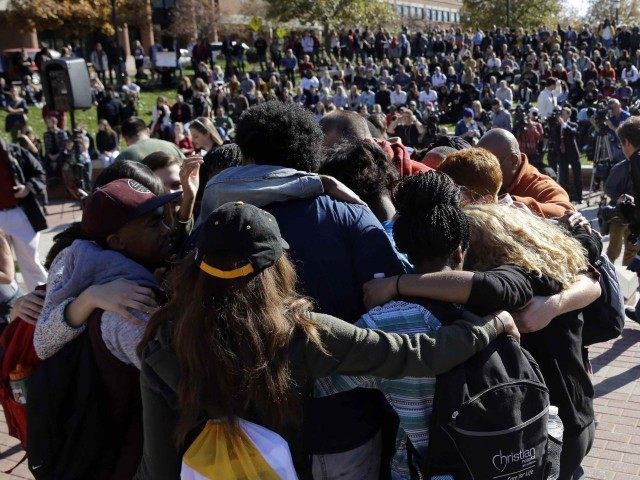David Vetter, born in 1971 with severe combined immunodeficiency (SCID)—a hereditary disease dramatically weakening the immune system and incurable at the time—died at age twelve. Spending his short life living inside a plastic bubble that sought, unsuccessfully in the end, to protect him from the world of germs outside, he was dubbed “the bubble boy.”
As we look at what is taking place on college campuses around the country today, we are witnessing a similar effort to protect young people from the realities of the world around them. We provide them with “safe spaces,” removing any symbols deemed offensive. In shielding students from life’s slightest perceived unpleasantries, one wonders if we are not simply raising a generation of overly-protected “bubble children.” If so, we need question whether students’ best interests are served.
While the clarion call for safe space went out as claims of racism were “being met with a lack of empathy,” the call seems to have evolved into one seeking to accommodate students easily offended by any opposing viewpoint.
Ironically, offended students exercising their own First Amendment rights, by loudly complaining, seek to deny the same rights to those holding opposing views. The safe space concept has been abused to the point college administrators unabashedly provide “bubble space” for absurd reasons.
The call for safe spaces apparently ballooned in the wake of the 2016 presidential election as students proved unable to cope with its outcome.
For students thusly stressed at the University of Pennsylvania, a dorm made “Breathing Space” available. They were offered various stress-reducing activities, such as cuddling cats and a puppy, coloring, crafting or enjoying snacks of soothing teas and chocolates.
Feeling their pain, many professors at Penn canceled classes, turning them into safe space forums “in which students could freely express their concerns for their futures.”
Interestingly, an earlier campus poll revealed Hillary Clinton supporters outnumbered Donald Trump’s almost ten-to-one. Thus, while Hillary supporters, participating in such classroom forums, discussed their fears about his victory, apparently no similar concerns existed about Trump supporters’ fears in expressing themselves within such a pro-Clinton environment.
At Cornell University, students upset over the election results were allowed to hold a “cry in.” Students wrote about their “emotions on poster boards with colored markers or with chalk on the ground.” Interestingly, at another university, someone simply writing “Trump 2016” in chalk on a sidewalk upset students who claimed they could no longer feel safe.
Even before the election, some universities, such as Case Western Reserve University in Cleveland, located only a few miles from the Republican National Convention, felt the need to provide safe space for anyone “psychologically or physically traumatized” by the event.
Meanwhile, earlier this year, with Halloween approaching, the University of Florida made counselors available 24/7 should students feel upset over costumes encountered.
At the University of Iowa, a professor expressed concern a popular item on campus was “conveying an invitation to aggressivity and even violence,” possibly even causing depression and promoting a suicide culture among students. The offending item in question was the “angry” look frozen on the face of the school’s hawk mascot. The professor wrote, “I believe incoming students should be met with welcoming, nurturing, calm, accepting and happy messages”—something she felt the hawk’s appearance did not convey.
The University of Wisconsin-Stout, perhaps acting preventively to avoid the need for safe spaces, dispatched a search team to identify anything impressionable incoming students might deem offensive on campus. Coming across two historic paintings of colonial settlers and Native Americans, the team recommended removal fearing the “harmful effect” they might have. The administration complied.
As one critic asks, “who created these campus whiners?” He notes campus unrest of the 1960s focused on things of great consequence—the Vietnam war, civil rights, etc. But, today, universities are creating “whiny college kids…screaming obscenities or taking over the university president’s office…for…feeling slighted…(They are) rebels without a cause.”
Such coddling of our college students has consequences, not only for them but for the universities as well.
A psychologist writes, as “college personnel everywhere are struggling with students’ neediness,” universities are creating a serious problem—“declining student resilience.” Resilience is described as “that ineffable quality that allows some people to be knocked down by life and come back stronger than ever. Rather than letting failure overcome them and drain their resolve, they find a way to rise from the ashes.”
Clearly, by promoting a victim culture to students, colleges prime them for failure in the real world.
University alumni are also disgusted with such student pampering, reflected by a downturn in donations. Enrollment suffers too as applications to universities known for coddling, such as the University of Missouri, have drastically declined.
As American college students seek safe harbor in a protective bubble, it gives one pause to reflect on their counterparts in the Ukraine. Students there must live every day fearing attacks by pro-Russian separatists seeking to topple their government.
Accordingly, many such students have voluntarily joined the Students Guard—an auxiliary guerilla force trained to take up arms in an emergency. Independent of the government, the Guard represents civilian society’s concerns about the political realities facing the country. Professors are responsible for preparing these students for war.
At the Ukraine’s Taras Shevchenko National University, a safe space does exist on campus. Students often will stand there, shoulder-to-shoulder, in complete silence. The space is reserved for photos and tributes to students who, answering the nation’s call to duty, failed to return.
For Ukrainian college students, no other safe space exists.
Tom Brokaw described America’s World War II generation as our greatest. Sadly, most members from that generation have now left us. But, it is probably just as well, for they undoubtedly would be horrified to know their sacrifices have given rise to a pampered generation of “bubble children” unable to cope with life’s basic realities.

COMMENTS
Please let us know if you're having issues with commenting.